World War I & the Anzacs of the south east corner:
When fighting began in August 1914, Australia, as a member of the British Empire, automatically followed the “Mother Country”. The Australian Imperial Force (A.I.F.), raised by Bridges, was Australia’s main expeditionary force during the war, although an Australian Naval & Military Expeditionary Force, Royal Australian Navy & the Australian Flying Corps also took part.

1709 Private Ernest Wilford Targett, 26th Battalion, AIF,
of Pambula. Enlisting on 24 May, 1915 & embarking on board A9 HMAT
Shropshire on 17 August 1915 Pte Targett served at Gallipoli where he was
wounded on 21 November, 1915. Two weeks later, he died at the No. 15 General
Hospital, Alexandria, aged 24. Pte Targett was buried Alexandria (Chatby)
Military & War Memorial Cemetery, Egypt.
During WWI, the main areas in which the ANZACS fought were the Dardanelles, during the Gallipoli campaign; the Middle East in Egypt & Palestine, where the Light Horse played a notable role; & on the Western Front in France & Belgium, where Australian soldiers were particularly prominent in the attacks at Pozieres (July–September 1916); Bullecourt (April–May 1917); Third Ypres (September–November 1917); the counter attack at Villers-Bretonneux (April 1918); & at Amiens (August 1918). Australian troops were also involved elsewhere.
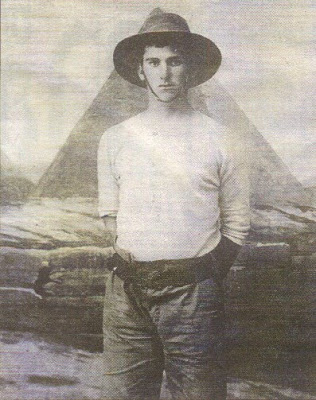
2113 Private John Hampden Beasley, 20th Battalion, AIF,
of Towamba. After enlisting on 21 June, 1915, he landed on Gallipoli, where he
remained until the evacuation, apparently being one of the last to leave the
peninsula. Pte Beasley then fought on the Western Front where he was shot during
the Battle of Pozieres Ridge on 26 July, 1916. Returning to Australia on board
H. T. Wiltshire, he was discharged as medically
unfit.

6602 Private Lindon George Albon (“Lin”)
Peisley, 19th Battalion, A.I.F., of Pambula. Enlisting in July 1916 Pte Peisley
served on the Western Front, where he was taken Prisoner of War (POW) at Mont
St. Quentin, near Peronne in September 1918. Just a month later he died while
still a POW & was buried at Le Chateaux Military Cemetery,
France.
The Australian forces suffered extremely high casualty rates. During WWI, Australian troops raised (excluding naval forces) numbered 416,809; of these 331,789 took the field. Casualties numbered 215,045; of which 59,342 were killed. Compare this with the nation’s population in 1916 - 4,875,325.

2175 Lance Corporal Vincent James Martin Longhurst, 55th
Battalion, of Pambula. Enlisting in January 1915, L Cpl Longhurst embarked with
the 4th reinforcements on A15 HMAT Port Sydney. Wounded in the First Battle of
Bullecourt on the Western Front, he died in May 1917, aged 22. He was buried in
the Grevillers British Cemetery, France. (Image from the Australian War
Memorial collection.)

3219 Private Raymond Edward Stevens, 54th
Battalion of Bega. Enlisting on 2 August 1915 & embarking on 20 November
1915 aboard HMAT Suevic Pte Stevens served on the Western Front. During the
Battle of Fromelles, he was captured at Fleurbaix on 20 July 1916 & was held
as a POW until being repatriated to England on 14 February 1918. He arrived back
in Australia on 4 March 1919. (Image
from the Australian War Memorial collection.)

1090 Sergeant James Gordon, 3rd Battalion, AIF, of
Wolumla. Enlisting on 21 August, 1914, & embarking aboard A14 HMAT Euripides
on 20 October 1914, Sgt Gordon was wounded three times at Gallipoli. Later, on
the Western Front, he was killed in action some time between 22 & 27 July,
1916 during the Battle of Pozieres Ridge, aged 21 years. Sgt Gordon has no known
grave but is remembered on the Villers-Bretonneux Memorial,
France.
(Image from the
Australian War Memorial collection.)
84 Sergeant Francis Henry Robinson, 1st Light Horse Regiment, of Eden. Enlisting on 22 August, 1914, Sgt Robinson landed on Gallipoli on 25 April, 1915. After suffering a gun shot wound on 7 August, 1915, he embarked on 25 June 1916 on board “Euripides” from England for Australia where he was discharged as medically unfit.

2219 Private Roy Davidson, 1st Battalion, AIF, of Eden.
Enlisting in June 1915, he served at Gallipoli & then the Western Front.
Reported missing during the Battle of Pozieres Ridge some time between the 22
& 25 July, 1916, Pte Davidson’s remains were never found. He was aged 21. He
has no known grave, but is remembered on the Villers-Bretonneux Memorial,
France. (Image from the
Australian War Memorial collection.)

1360 Corporal George Silvester Goward, 1st
Infantry Brigade, of Kiah. Enlisting on 20 November, 1914, he embarked on A48
HMAT Seang Bee on 11 February, 1915. After serving at Gallipoli from 25 April,
1915 until the December evacuation, he went on to the Western Front. Cpl Goward
was killed in action on the Menin Road during the Third Battle of Ypres on 8
September, 1917, aged 24. He was buried in the Menin Road South Military
Cemetery, Belgium. (Image from the Australian War Memorial
collection.)

3134A Private Ronald G. (“Ron) Dowling,
55th Battalion, A.I.F., of Pambula. Enlisting in 1916 & serving on the
Western Front in France, Pte Dowling was awarded the Distinguished Conduct Medal
(DCM) for “conspicuous gallantry & devotion to duty” during the Polygon Wood
battle in 1917. He returned to Australia in June
1919.

52681 Corporal Eric Napier Munn, 2nd Field
Squadron, Anzac Mounted Division, of Merimbula. Formerly a member of the Bega
Lighthorse squadron, Cpl Munn enlisted on 8 November, 1917, & embarked from
Sydney on board HMAT Wiltshire on 10 June, 1918. After serving on the Western
Front, he returned to Australian on 26 July, 1919. (Image from the Australian War Memorial
collection.)

3948 Private Leopold Arthur
Alfred Strickland, 18th Battalion, of Eden. Enlisting in October 1915, Pte
Strickland embarked on board A54 HMAT Runic on 20 January 1916. served on the
Western Front. While serving on the Western Front, he was killed in action at
Pozieres during the Somme offensive, on 4 August 1916. Pte Strickland was 19
years of age. He has no known grave, but is remembered on the Villers-Bretonneux
Memorial, France. (Image from the Australian War Memorial
collection.)

4571 Corporal W. H. (“Bill”) Denny, 4th
Battalion, A.I.F. Born at Rocky Hall in 1880, Bill Denny was wounded on three
occasions while fighting in France. A serious head wound at Pozieres saw him
declared dead & he was put with others killed in action. Three days later,
after he was heard to moan, he was rescued to survive the
war.

4359 Private Walter Francis Reid, 29th Battalion, of
Wyndham. Embarking with the 11th Reinforcements on HMAT Afric on 3 November
1916, Pte Reid served on the Western Front, where he was killed in action at
Messine, Belgium, on 16 December 1917. He was 24 years of age. Pte Reid has no
known grave, but is remembered on the Ypres (Menin Gate) Memorial,
Belgium. (Image from
the Australian War Memorial
collection.)
Gallipoli:

2149 Lance Sergeant Henry Thomas John McGrath,
3rd Battalion, AIF. Born near Bega, Lce Sgt McGrath enlisted on 5 October 1914
& embarked on board Derflinger on 5 April 1915. Twice wounded on Gallipoli,
he then served on the Western Front. He was killed in action during the Second
Battle of Bullecourt on 5 May, 1917, aged 21. Buried during battle near the
Hindenburg Line, L Sgt McGrath has no known grave, but is remembered on the
Villers-Bretonneux Memorial, France. (Image from the
Australian War Memorial collection.)
25 April 1915 is a date etched in Australia’s history. Aiming to force Turkey out of the war & open a safe sea route to Russia, the ANZAC troops landed on the shores of the Gallipoli peninsula at the place that became known as Anzac Cove. Although Turkish resistance was strong, further landings were made, but fighting reached a stalemate. The Allied troops were withdrawn in December 1915 & January 1916. Australian casualties on Gallipoli numbered 9,587 killed & 19,367 wounded.

312 Company
Quartermaster Sergeant Lancelot Gordon Meek, 2nd Battalion, of Eden. Enlisting
on17 August 1914 & embarking on A23 HMAT Suffolk on 18 October, 1914, CQMS
Meek was twice wounded after landing at Gallipoli on 25 April 1915. After also
serving in the Middle East, he was killed in action on 6 November, 1917 at
Passchendaele during the Third Battle of Ypres, aged 22. CQMS Meek was buried at
Tyne Cot Cemetery, Belgium.
The anniversary of the Gallipoli landing is commemorated across the country each year as ANZAC Day. 2010 marks the 95th anniversary of this event, which, for many, is regarded as Australia’s most important national day, some seeing it as Australia’s “baptism of fire” and our “birth of nationhood”.

2731 Private Ronald
Thompson Munn, 1st Battalion, AIF, of Merimbula. Enlisting on 27 April 1915, Pte
Munn served at Gallipoli where he was killed in action on 24 November 1915, aged
31 years. He was buried in the Shell Green Cemetery, Gallipoli, Turkey.
(Image from the Australian War Memorial
collection.)
“The Great War profoundly affected even those nations which were farthest from the chief theatre, not only because of the range of its political & economic effects, but because it partook of the nature of a crusade.”
C. E. W. Bean.

2390 Private Charles Edward
Walsh, 16th Reinforcements, 4th Light Horse Regiment, of Wolumla. Enlisting on
12 January 1916 & embarking aboard HMAT Itria on 18 April 1916, Pte Walsh
served in the Middle East before returning to Australia on 15 June
1919.
(Image from the
Australian War Memorial collection.)
The reaction of the people of the far south coast to the declaration of war in 4th August 1914 can be gauged from the reports in local newspapers.

3735 Private Harold Ambrose
Grant, 1st Battalion, A.I.F., of Wyndham. Enlisting on 23 August 1915, Pte Grant
embarked with the 12th Reinforcements on RMS Mooltan on 11 December 1915. While
serving on the Western Front, he was killed in action on 6 May 1917 during the
Second Battle of Bullecourt, aged 28. Pte Grant is buried in the Cabaret-Rouge
British Cemetery, Souchez, France. (Image from the Australian War Memorial
collection.)

4128 Gunner James Augustine Hanscombe, 5th
Australian Divisional Ammunition Column, of Bega. Gnr Hanscombe enlisted in
October 1915 & while serving on the Western Front, was awarded the Military
Medal (MM) for his actions on the 6/7th October 1917 during the Battle of the
Menin Road, Belgium. He returned to Australia on 2 June 1919.
(Image from the Australian War Memorial
collection.)

4128 Gunner James Augustine
Hanscombe (left) & his best mate, 4068 Private Joseph Britten, 17th
Battalion, both of Bega. Embarking with the 10th Reinforcements on 8 March 1916,
they transferred to the 5th Divisional Ammunition Column. During the Battle of
the Menin Road, Belgium, on 6 October 1917, Gnr Hanscombe was awarded the
Military Medal (MM) for “bravery & devotion to duty”, attempting to rescue
Pte Britten, who was killed during the battle, aged 25 years. Pte Britten is
buried at the Birr Cross Roads Cemetery at Zillebeke, Belgium. Gnr Hanscombe
returned to Australia on 2 June 1919. (Image from the
Australian War Memorial collection.)
In a small community, every enlistment aroused personal interest & the details were given in the local newspapers.

The first local recruits
are farewelled by family & friends at Tathra wharf during
1914.

Some of the first local volunteers waiting
on Tathra wharf to embark on the SS Merimbula, 1914.
Recruitment marches:
One of the after affects of the disastrous Gallipoli campaign was the reduction in numbers of Australian men enlisting in the services.
In October 1915 a group of 35 men from the Gilgandra district set out on a march to Sydney, recruiting men along the way, calling out “COOEE” as they walked. They arrived in Sydney in December with 277 men. This march was replicated over the country, using different names – Dungaree, Cockatoo, Kookaburra – from Queensland, the Riverina, Maitland & Parkes, the Snowy River & the South Coast.

“The Men from Snowy River” recruitment march of 1916
travelled through the Monaro from Delegate to Goulburn, but also included men
from Pambula, Eden & Bega, who joined en route.
Australian
War Memorial: MSS0821 – “The Snowy River Marchers, their war effort and
afterwards” by W C Stegemann.
Permission to use this marvellous account of the
march and its participants has been granted by Luke Stegemann <luke@melbournereview.com.au>

Group portrait of members
of 55th Battalion who enlisted in “The Men from Snowy River” recruitment march
through the Monaro in January 1916. Of the twenty men shown in the group, eight
died on active service. (Image from the Australian War
Memorial collection.)

Some of “The Men from Snowy
River” volunteers in camp at Goulburn. (Image from the
Australian War Memorial collection.)
One Pambula resident can remember when she was a child, travelling on a train & seeing from the window a group of men marching in the Cooma area.
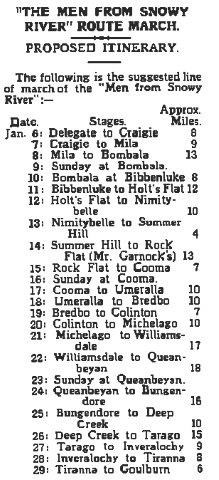
Queanbeyan Age and Queanbeyan Observer (NSW : 1915 - 1927) Friday 3 December 1915
Supplied by Sandra Young
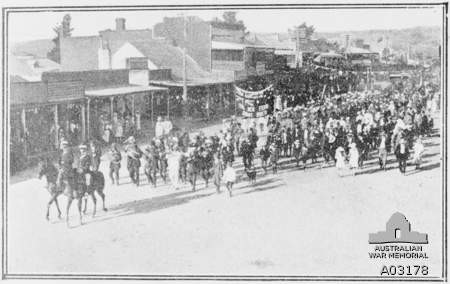
Recruits from Delegate carrying the banner of 'The Men from Snowy River' as they march through a town enroute to Goulburn.
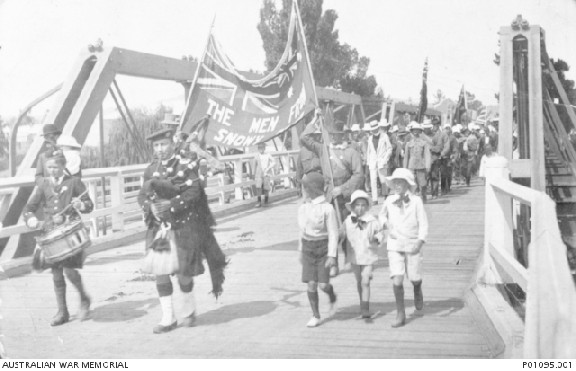
Men who have joined the Snowy River recruiting march, crossing the Queen's bridge led by a piper and drummer in front of the banner reading "THE MEN FROM SNOWY RIVER."
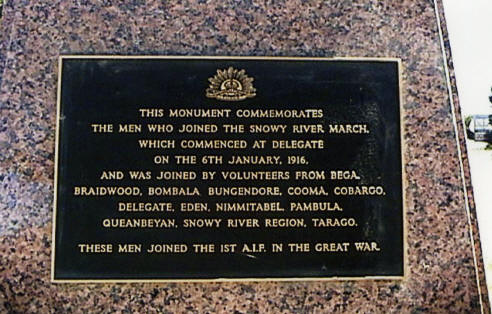 |
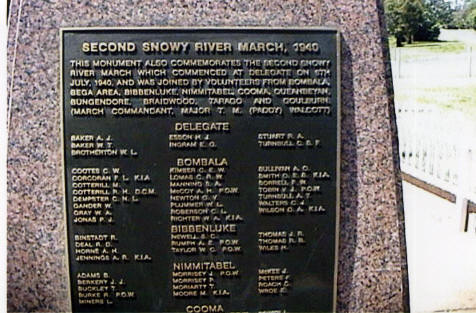 |
| 1st Snowy River March - Delegate | 2nd Snowy River March - Delegate |
Photos provided by Patricia McGufficke
March to Freedom:
In 30th July 1918, the March to Freedom passed through Pambula & the Voice reported on 2nd August: “The long expected South Coast “March to Freedom” contingent of the A.I.F. have arrived, done their bit, & passed to the next town. The contingent of about 40, including 15 of a militia band, under the charge of Lieutenant Healey, arrived at 12.30 pm from Eden…when they were followed by the local school children & marched through the town to the School of Arts…the soldiers were equally divided between the two hotels…In the evening there was a concert in the packed hall… The soldiers asked if anyone would give them an Australian flag to take to France, plant it in Berlin, & bring it back again; Mr. Wilkins came forward with his fine flag, followed by Mrs. Baddeley giving a similar one; Messrs English & Stewart donated a French & Belgian flag respectively…The contingent left on Wednesday morning for Wolumla…”

The “March to Freedom” recruitment drive in Quondola
Street, Pambula, on July 30, 1918.

“March to Freedom”
volunteers in camp at Goulburn.

The ‘Southern Cross’ tank promoting war
bonds
outside the Towamba Wine Saloon.
During the war years, social events were held to raise money for various
causes. The Pambula Voice newspaper reported:
“The monthly
social with euchre party & dance will be held at the Roan Horse on Wednesday
next in aid of the War Chest Fund.”
“April 26 next has been set down for
a special Red Cross appeal to provide to our soldier prisoners with food &
necessaries, etc.”
“The [Nethercote] school girls are busy knitting. They
hope to be able to send away 1 ½ dozen pairs of socks to the Eden War Chest
shortly.”

Allies Day in Carp Street,
Bega, C.1916
Casualties were reported through the media with sorrow &
returning soldiers greeted in style.
“A welcome home will be tendered
Corporal “Wally” Falkner in the Pambula School of Arts on Monday evening, &
everyone is invited to attend & assist to make the event a worthy memoir of
Pambula’s born [sic] first returning soldier, who has been through Gallipoli
& France & now comes home a wounded defender of his country. Come along
boys & girls, bring refreshments with you, & assist in honouring a man
to whom honour is due. During the evening songs, recitations, speeches, etc will
be rendered. Attend & help make a record reception & pleasant evening.
Good music, your own refreshments & a good time.” (Pambula Voice,
10 August, 1917.)

Light Horsemen & foot
soldiers are welcomed home at a parade in Auckland Street,
Bega.
The following supplied by Michelle Ambrosini [mambro-at-iprimus.com.au] 24.08.10
Queanbeyan Age and Queanbeyan Observer (NSW : 1915-1927), Tuesday 31 October 1916, page 2
National Library of Australia http://nla.gov.au/nla.news-article31672753
SNOWY RIVER SOLDIERS.
MESSAGE BY BOTTLE POST.
The 'following
letter, written by a number of "The Men from Snowy River," was picked up in a
bottle on the beach near Cape Schanks, by Misses R. Russell and E. Cairns. It
was addressed to the editor of the "Adaminaby Advocate":- “Going through
Melbourne Heads.
"We are just writing you a note, if ever you get it, to say we had a good time
all the way from Sydney. All on board being fairly well to-day, but some of the
Snowies are a bit sea-sick, as it was a bit rough. We had a few hours' leave in
Melbourne, and had a good look around. The following send their name; and wish
to be remembered to friends in their town of Adaminaby: S. H. Turner, E. Power,
F. J. Ree, Alf. Tozer, G. Mansfield. J. Turner, A. Goodman, J. J. O'Neill. E. C.
W. Venables, L. Freebody."
The following photo supplied by Lyn Byrne [lwbyrne-at-bigpond.com] 8.02.11
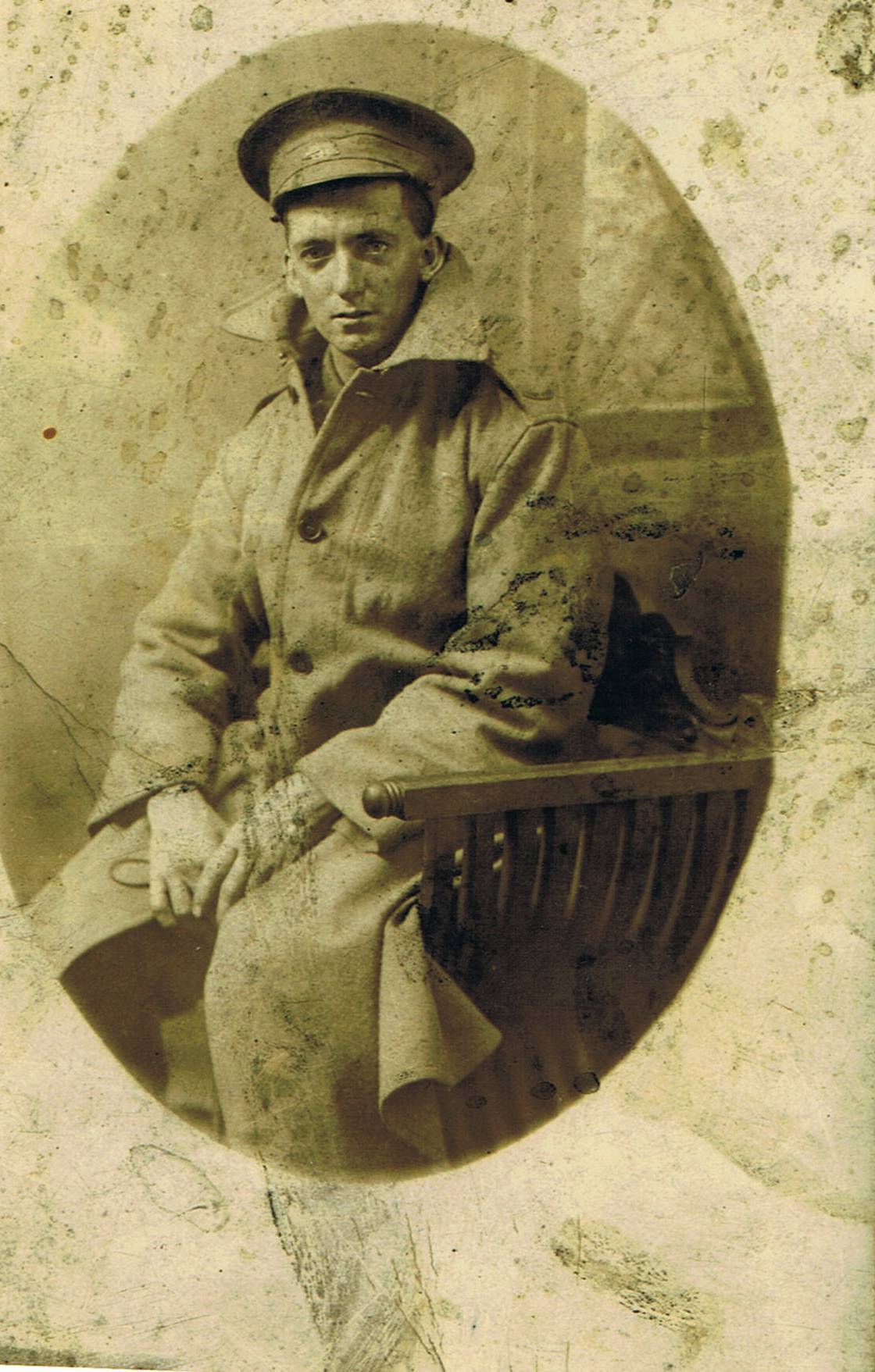
Dennis James Noonan
Dennis was born 20/4/1896 at Pambula, NSW.
His service number is 50377. He was in the Australian Light Horse. 1st G.S. Rfts
N Egypt ( General Service Reinforcements in North Egypt) and later assigned to
4th AMGS (4th Australian Machine Gun Squadron).
The following photo was supplied by Meryl Naismith [meryl_n-at-ozemail.com.au] 28.04.11
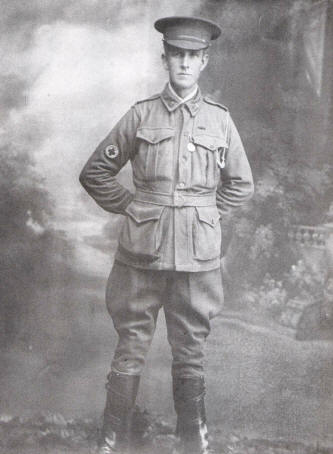
Albert Charles "Charles" McFarlane
Charles was born January 15, 1874 in Cooma, NSW. He served in the Army
as a Lance Corporal, number 605A, 1st Field Ambulance from October 26, 1914 to
October 8, 1919 in WW1. His unit embarked from Melbourne, Victoria, on board
HMAT A35 Berrima on 22 December 1914.
The following photo was supplied by Julie Hopper [hopper.n-at-bigpond.com]
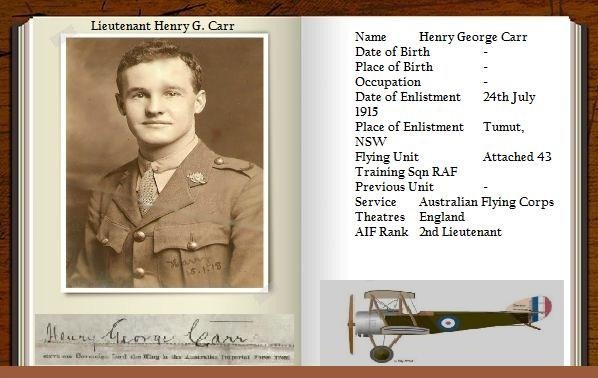
Death: 11 May 1918 in England - Died as a result of accident
The following photos were supplied by
Peter Toms <ptoms-at-diamondwines.com>
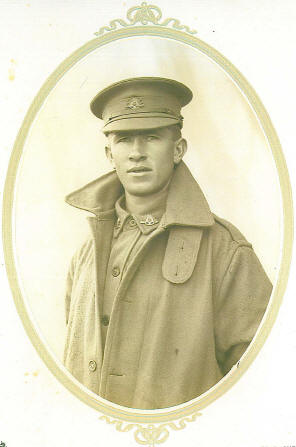 |
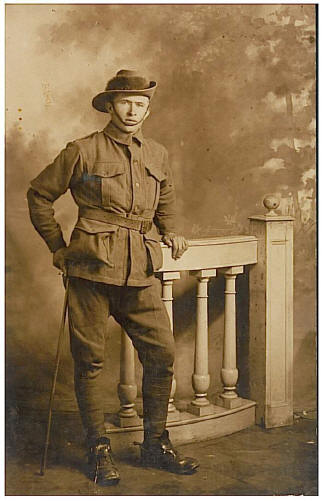 |
|
|
The Following Photo supplied by Geoff Todd [todd52-at-bigpond.com] 4.05.12
|
|
|
|
.jpg) |
| Lieutenant Colonel Thomas Joseph Lynch |
Thomas Joseph Lynch was a professional soldier who retired with the rank of Honorary Lieutenant - Colonel (having served some 35 years with the R.A. Garrison Artillery and as a staff officer with the Australian Military Forces). After attending St Patrick's College Goulburn he enlisted in the NSW Artillery on 18 January 1879. By 1885 he had been promoted sergeant and had served with the NSW contingent during the Sudan War. At the outbreak of the Boer War he was commissioned as Second Lieutenant in the NSW Citizen's Bushmans Brigade and on 1 April 1900 was promoted Lieutenant. He served with distinction throughout the Boer War and was promoted Captain and appointed transport officer of Colonel St George Henry's Column. At the outbreak of World War1 he was granted a Commission as a full Major and appointed Brigade Major of the 2nd Light Horse Brigade in the Australian Expeditionary Forces for service overseas in WW1 on 17 September 1914 for the duration of the war plus one month. He was initially posted to the Head Quarters of the 2nd Light Horse Brigade and then shipped overseas on 16 May 1915 to Anzac Cove. While serving in the front lines at Gallipolli he contracted severe conjunctivitis in both eyes as a result of exposure and strain in the firing lines. He was repatriated from front line duties by order of the Surgeon General in Cairo, Egypt. He subsequently embarked on the Hospital Transport "Argylshire" for return to Australia from Suez on 3 March 1916 following a Medical Board of Enquiry which, because of his defective eyesight, found him unfit for service in the field or at the front. He died on 30 November, 1921 and was buried in the Catholic Section of Randwick Cemetery. He is best remembered for his leadership, training and administrative qualities both in war and peace and for active service spanning Australia's involvement in three wars.
(Information copied from his Biographical Entry in the Australian Dictionary of Biography - Online Edition and details included in documents from his military service records held in the National Archives in Canberra).Photo and information supplied by Des Smith [des_pam-at-people.net.au]
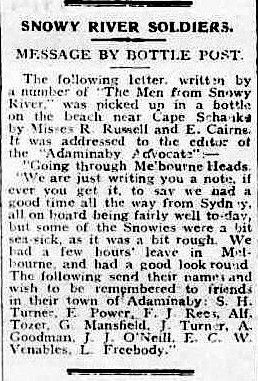
Letter to the Adaminaby Advocate 1916
Supplied by Rosemary Stewart-Beardsley
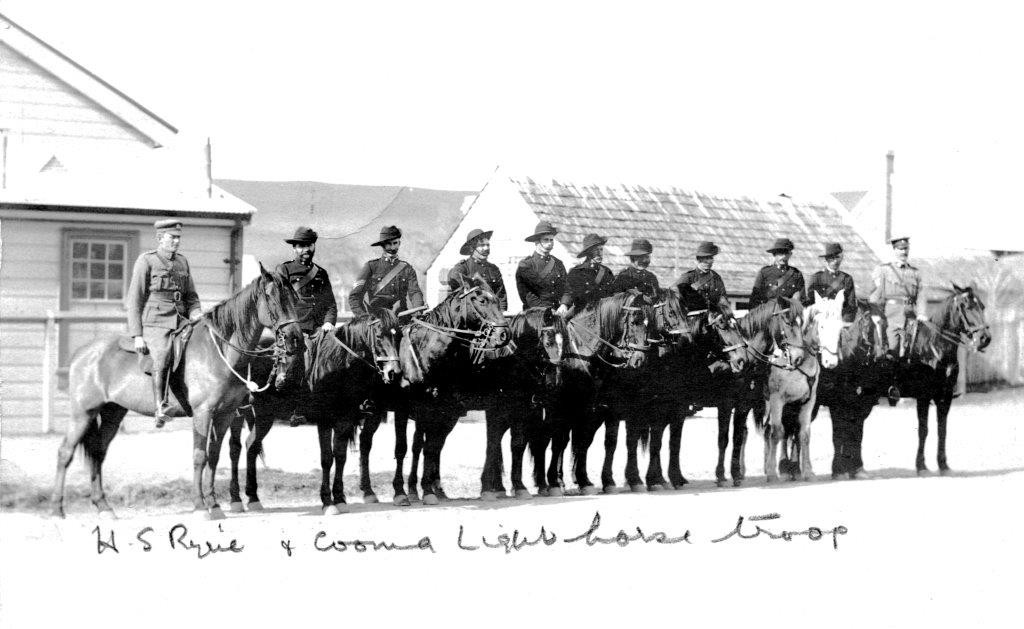

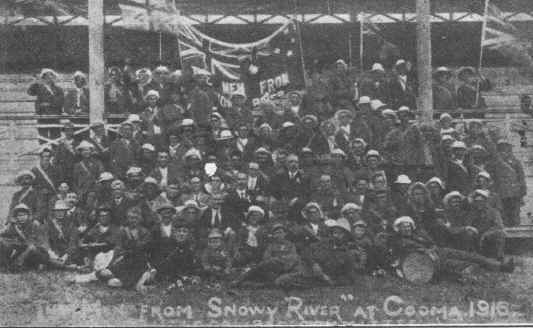
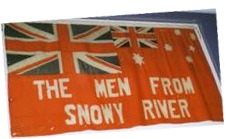
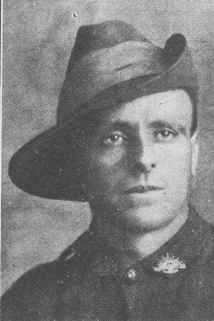
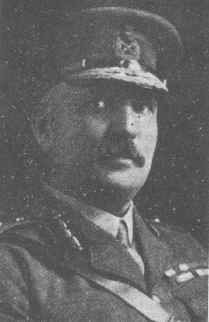
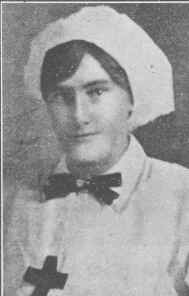
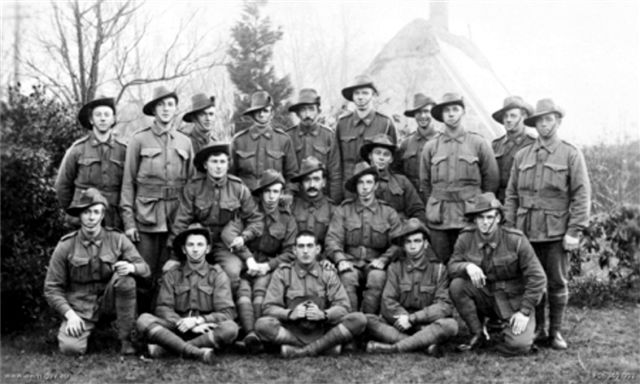
 Monaro
Pioneers
Monaro
Pioneers